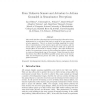Free Online Productivity Tools
i2Speak
i2Symbol
i2OCR
iTex2Img
iWeb2Print
iWeb2Shot
i2Type
iPdf2Split
iPdf2Merge
i2Bopomofo
i2Arabic
i2Style
i2Image
i2PDF
iLatex2Rtf
Sci2ools
CONNECTION
2006
2006
From unknown sensors and actuators to actions grounded in sensorimotor perceptions
This article describes a developmental system based on information theory implemented on a real robot that learns a model of its own sensory and actuator apparatus. There is no innate knowledge regarding the modalities or representation of the sensory input and the actuators, and the system relies on generic properties of the robot's world such as piecewise smooth effects of movement on sensory changes. The robot develops the model of its sensorimotor system by first performing random movements to create an informational map of the sensors. Using this map the robot then learns what effects the different possible actions have on the sensors. After this developmental process the robot can perform basic visually guided movement.
CONNECTION 2006 | Real Robot | Robot | Sensory Input |
| Added | 11 Dec 2010 |
| Updated | 11 Dec 2010 |
| Type | Journal |
| Year | 2006 |
| Where | CONNECTION |
| Authors | Lars Olsson, Chrystopher L. Nehaniv, Daniel Polani |
Comments (0)

